Tong W. Wind Power Generation and Wind Turbine Design
Подождите немного. Документ загружается.

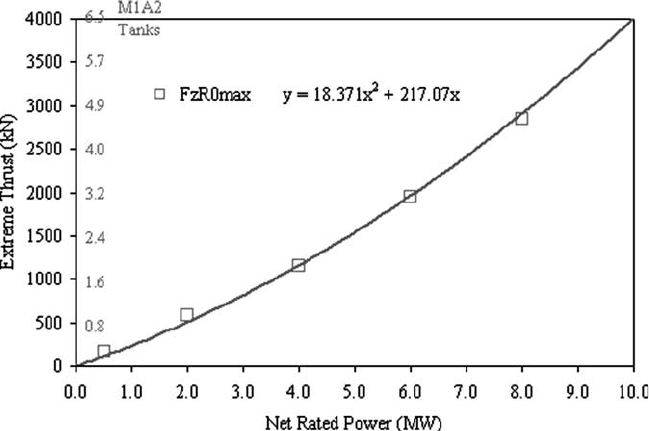
Design and Development of Megawatt Wind Turbines 215
particularly at the different attachment and component transitions throughout the
turbine. Goodman diagrams are used to estimate fatigue life for various stress
ratios experienced throughout the critical locations [47]. These fl uctuating loads
often dictate the fi nal sizing of structural members (beyond what is required for
extreme loads). The utility scale WT sees more fatigue load cycles than any other
manmade structure or machine – many millions of cycles over its 20-year design
life – more than automobiles, ships, aircraft or rockets.
4.3 Components
Figure 14 illustrates the top-level mass results from the value analysis program.
The extreme and time-varying loads for the 10-turbine analysis group (i.e. Table 1 )
are converted into the amount of material or mass that the various components
need in order to meet the design requirements for the turbines. The results are for a
selection of component technologies that are most often used today and include:
Nominal glass fi bre reinforced plastic (GFRP) blades optimized for structural 1.
properties and lowest weight.
Nominal characteristics of a main shaft incorporating a single forward main 2.
bearing or a double-bearing design.
Nominal gearbox with the number of stages required carrying the torque for a 3.
speed-up ratio in the range of 1:100 or more.
Electrical generator spanning the range of wire wound doubly fed induction to 4.
permanent magnet full-power conversion topology.
Figure 13 : Calculated extreme thrust for the 10-turbine analysis group.
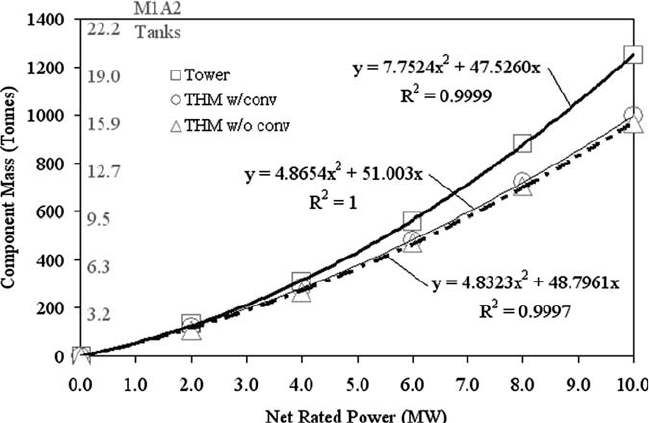
216 Wind Power Generation and Wind Turbine Design
Typical cast or large fabricated bedplate used in today’s workhorse turbines. 5.
Tubular steel tower, with the tower bottom diameter scaled for the same aspect 6.
ratio versus height, with the height taken along the industry study set trend as a
function of turbine net power rating.
Simple scaling rules for shipping logistics assumed to apply across all the com-7.
ponents, even for the high end of the rated power range. This last assumption
is the most diffi cult to accept as the larger onshore machines in the 7 − 10 MW
size range could not actually ship 80 m long blades or tower bottom diameters
approaching 7 m. However, the turbine solutions are valid in terms of physical
parameters in situ, and provide a convenient benchmark for the turbine designer
striving to overcome the logistics problem with new technology and innovation.
The effect of including the converter up-tower is hardly noticeable but the tower
itself outweighs the THM by 25% in the higher 7 − 10 MW size range. Tower and
THM in the 500 − 1000 tonne range (weight of 9 − 16 Abrams M1A2 tanks) are not
economically viable using today’s readily available technologies. This view pro-
vides a starting point for imagining what materials and construction technologies
are needed to make these large machines possible.
Figure 15 further breaks down the THM into the major sub-systems. The partial
nacelle is the heaviest and includes the massive bedplate for transferring the rotor
bending moments into the tower structure, as well as the covering (i.e. nacelle) that
keeps the weather from the drivetrain components. The lightest components are the
generator, bearing and converter. As mentioned before, the converter is positioned
up-tower in some designs, although the most prevalent location is down-tower.
Figure 14 : Calculated tower and THM results for the 10-turbine analysis group.
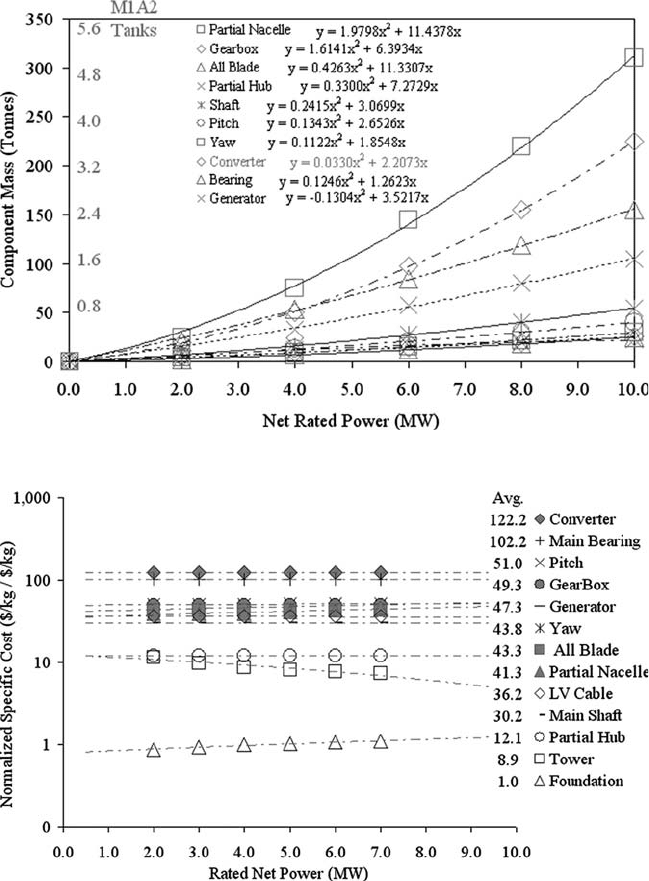
Design and Development of Megawatt Wind Turbines 217
4.3.1 Impact to component cost
The next step in the value analysis method is to convert the component mass
requirements into their respective cost. This is more diffi cult than estimating the
loads and mass of components due to the endless change in costs for factors such
as sourcing options, materials, labour, transportation and currency exchange.
Figure 16 shows the levels and relatively fl at trends for component specifi c cost
Figure 15 : Calculated component mass results for the 10-turbine analysis group.
Figure 16 : Normalized specifi c cost results for the 10-turbine analysis group.
218 Wind Power Generation and Wind Turbine Design
as a function of the WT rated net power. On a cost per kg basis, the converter,
main bearing and pitch systems are the most expensive. At the other end of the
spectrum, the partial hub, tower, and foundation are the least expensive. The foun-
dation is considerably less expensive than any other component on a $/kg basis.
However, the foundation is by far the heaviest component – typically two to three
times the mass of the WT itself.
Accurate cost data for the actual component technologies under consideration
are crucial for making proper assessments in the value analysis methodology. The
best way to ensure the accuracy of this information is for the OEM’s Sourcing
Department to provide these fi gures (normalized to eliminate the largest varia-
tions) and for routines to be established to store the data for the value analysis
program to automatically use the latest information.
4.3.2 Power performance calculations
The method used to calculate the performance of a WT is to use a power curve
together with the annualized wind distribution for a given project location. The
power curve plots the power produced by the WT as a function of wind speed. The
power production quoted by an OEM is typically given at either the low voltage
(LV) or high voltage (HV) terminals of the medium voltage (MV) transformer
depending on the supply scope for the customer. Losses from cables and converter
are more commonly included in the turbine losses along with other conversion
losses within the turbine OEM scope of supply. Sometimes an OEM may quote
output at the generator terminals, and additional losses for the LV cables, con-
verter, MV transformer, MV cables and wind plant collection and substation must
be properly accounted. The end goal is to ensure the accurate determination of
electricity production (i.e. “at the meter”) used to compute revenue.
4.3.3 Acoustics and vibrations
WT acoustic and vibration design falls into three major categories:
WT rotor system acoustics •
Machinery structure-borne noise •
Machinery and airborne noise •
The rotor blade and operating controls impact the rotor system acoustics. The
direct acoustic pressure radiation and the forces that drive vibrations in the machin-
ery structure contribute to airborne noise emission. Noise is an important factor
during the conceptual design of most new MW turbines, particularly for onshore
machines targeted for land-constrained markets. Today’s 1 − 3 MW turbines are
designed to emit maximum noise in the range of 102 − 106 dBA at HH. This pro-
duces actual measurements of 35 − 45 dBA observed 300 − 400 m from the tower
base at ground level, similar to the background sound experienced in a bedroom at
night or quiet conversation around the dinner table.
4.3.4 Thermal management
Electrical components and sub-components housed in close quarters can quickly
lead to over-temperature and unnecessary production loss. MW WTs are subjected
Design and Development of Megawatt Wind Turbines 219
to the full range harsh environmental conditions, and these need to be accounted
to ensure reliable operation and maximum revenue.
4.3.5 Dynamic systems analysis
Turbines and components, like all physical objects, have natural frequencies.
External load sources, operational scenarios and moving parts are potential
stimulus and dynamic reinforcement sources. Relative defl ections and stiff-
nesses for large structures is an extremely acute consideration in the design of
robust MW WTs.
WT tower stiffness is a key consideration to the overall structural design of
WTs. To avoid resonance, the tower’s natural frequency ( f
0
) must not coincide
with the frequency of the cyclical loading resulting from the rotor frequency ( f
r
)
and the frequency for the blades passing in front of the tower ( f
b
). Towers and
turbine systems are classifi ed as soft − soft, soft − stiff, or stiff − stiff, depending if the
tower’s natural frequency is less than the rotor frequency ( f
0
< f
r
), greater than the
rotor frequency but less than the blade passing frequency ( f
r
< f
0
< f
b
), or greater
than the blade passing frequency ( f
0
> f
b
), respectively [ 25 ]. This is best viewed
relative to a Campbell diagram for the tower and stimulating frequencies, where to
avoid resonance the turbine power producing speed region is defi ned using mar-
gins no less than ± 5% [ 23 ]. The majority of large WTs are designed for the
soft − stiff regime. Soft − soft or soft − stiff are preferred over stiff − stiff because much
more material and cost are required for this later approach.
Sensors and controls are also used to avoid or mitigate resonance vibration, and
to ensure safe operation. This is a rapidly evolving development area for large
WTs, and holds promise for becoming a key technology for enabling larger “smart”
structures. These designs should be capable of withstanding higher loads with
superior performance while using considerably less material for a lower cost.
4.4 Mechanical
Materials for structures must be inexpensive, readily available, and easy to fabri-
cate, require minimum maintenance over the turbine’s 20-year or longer life, and
in the best scenario, be recyclable. When a conceptual design shows promise and
feasibility, the advanced mechanical design (AMD) function works out enough of
the details to warrant advancing further in the process.
4.4.1 Blades
Blades are one of the most important components in MW WT design. They directly
affect AEP and the loads imparted to the entire turbine structure. Blades endure
a large number of cycles for wind speed and direction, extreme gusts, and, with
every revolution, load reversals from their own weight. To be economically viable,
the cost of the material and manufacturing needs to be a fraction of the cost of
blades for aircraft or aerospace counterparts.
Aerofoil sections have max thickness to chord ratio (i.e. aspect ratio) of around
2 − 3 near the root and 5 − 7 near the tip. By comparison a wooden 2 × 4 has a fi nished
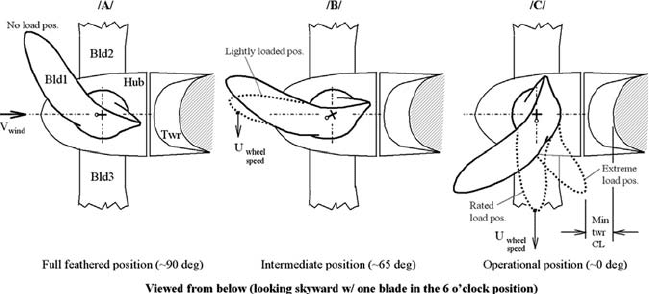
220 Wind Power Generation and Wind Turbine Design
aspect ratio of 3.5”/1.5” or 2.33 and a 2 × 8 is 7.25”/1.5” or 4.83. In either case it
is easier to defl ect the span in the fl at or shorter direction as opposed to the longer
dimension. For wind blades these load directions are referred to as fl apwise and
edgewise, respectively.
Blades are constructed to be as light as possible yet still providing the strength,
stiffness and life required by the system. This is achieved with internal structures
that incorporate either a box spar or shear webs. The box spar is a radial beam that
the aerofoil skins are bonded around. The shear web approach uses the aerofoil
skins as part of the spanwise structure with the internal shear webs transferring
loads from one side of the aerofoil to the other to form a defl ection resistant box
structure. Box spar construction has an advantage for longitudinal strength and
uniformity, but it is heavier and structurally ineffi cient relative to the shear web
approach. Both techniques are successfully used in today’s GFRP blades.
Figure 17 illustrates a number of typical blade design features as viewed by an
observer looking up from the base of the tower with the wind approaching the
turbine straight-on and travelling from left to right. Sketch /A/ shows the blade in
the 85 − 90° or fully feathered pitch position. In this position the blade is primarily
experiencing edgewise loading from the wind. Sketch /B/ shows the blade pitched
to the intermediate blade angle of 65 − 68° (as will be explained in subsequent sec-
tions, this is the position used to start and reinforce rotor rotation for the case of
increasing winds above cut-in wind speed). The blade in this position is experienc-
ing a combination of edgewise and fl apwise loads from the oncoming wind and
wind gusts. Sketch /C/ shows the blade pitched to the full operational angle of
around 0° – the position maintained throughout the variable speed region of the
power curve. In this position the blade primarily experiences fl apwise loads due to
the wind.
The combination of blade prebend, cone, drivetrain tilt and overhang can also
be seen in Fig. 17 . These design features are not of signifi cant consequence for the
pitch positions of sketches /A/ and /B/, where the blade is lightly loaded and span-
wise defl ections are small. However, blade spanwise defl ections are greatest for
Figure 17 : Blade design elements and pitch positioning.
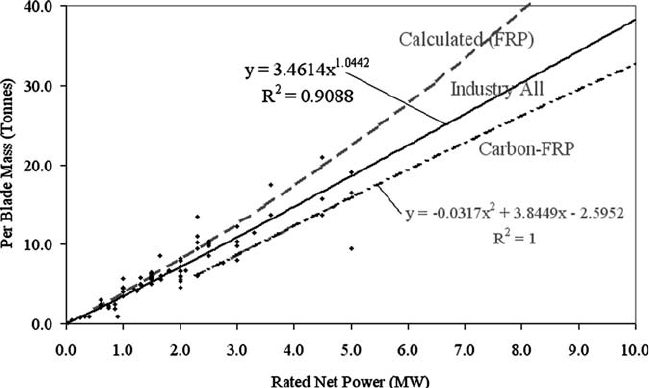
Design and Development of Megawatt Wind Turbines 221
sketch /C/ and for winds above rated wind speed. The maximum defl ection outline
shows another view of the importance for the minimum tower clearance discussed
earlier in this chapter.
Figure 18 shows the 10-turbine analysis group (i.e. calculated), a curve fi t for
the industry study set using GFRP, and the industry study set for carbon spar and
GFRP hybrids. Clearly if one just scaled today’s average technology to 10 MW,
the individual blade mass would be in excess of 40 tonnes. Since the larger
machines in the industry study set tend to incorporate a carbon spar or utilize some
form of an advanced GFRP construction, the industry trend projects the 10 MW
blade to be less than 40 tonnes. A carbon − GFRP hybrid blade should be able to
achieve 32 − 34 tonnes per blade. Based on the past industry progress going from
1 to 5 MW, and with new technology yet to be discovered, it may be possible for a
10 MW blade to be designed in the 25 tonne range.
The majority of today’s blades are made from GFRP incorporating either a box
spare or shear web construction. Figure 19 shows the typical mass and cost break-
down for an average sample of blades incorporating shear web construction [ 26 ].
The glass fi bre and epoxy or vinyl resin comprises the vast majority of the mass.
Manufacturing these blades requires a large amount of man-hours such that labour
accounts for nearly 1/3 of the total cost for a blade.
Today’s mainstream blade construction technology requires signifi cant invest-
ment in mould tooling to form, cure and assemble large WT blades. A steel sub-
frame and backing structure is used build-up the basic upper and lower mould
shell tools. Curing heaters (electrical or temperature controlled fl uid channels) are
arranged throughout the surfaces prior to establishing the fi nal mould surfaces.
These are typically completed using a prototype blade (i.e. plug) to provide a form
for the fi nal tool surface made from high temperature epoxy resin within the upper
Figure 18: Blade mass – 10-turbine analysis compared to industry study set.
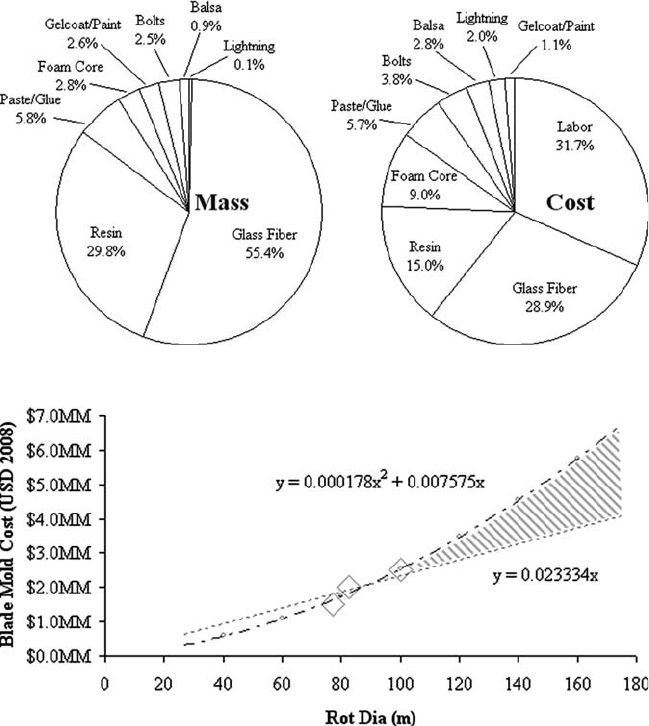
222 Wind Power Generation and Wind Turbine Design
and lower blade half moulds. The mould halves are hinged together to facilitate the
fi nal closure and bonding operation for normal blade production.
As shown in Fig. 20 , the cost of a blade mould for one of today’s typical 1 − 3 MW
WTs is around $2MM or more. A single mould can manufacture 600 − 1000 blades
before it will require refurbishment at a cost of $120K or more. Moulds can usu-
ally be refurbished at least two to three times before new replacements are needed
[ 27 ]. These trends imply that larger turbines in the 7 − 10 MW size would require
moulds that cost $4 − 6MM unless alternative technologies can be found. In reality
moving beyond rotor diameters of 120 − 130 m (i.e. 60 − 65 m long blades ignoring
the hub diameter) using GFRP blade construction technology is generally viewed
as too heavy and impractical so that new large blade technology will be needed to
improve this trajectory [58].
Figure 19 : Mass and cost breakdown for nominal GFRP blades.
Figure 20 : Blade mould tooling costs for nominal GFRP blades.
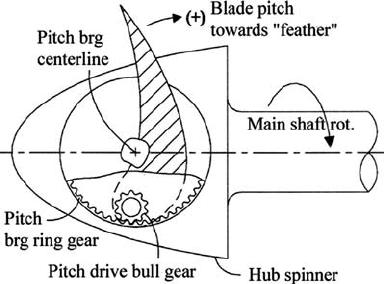
Design and Development of Megawatt Wind Turbines 223
Future large turbine blade technology may incorporate elements of dry nano-
technology, hybrid construction (i.e. inboard structure of one material joined
through one or more joints to outboard sections made of alternate materials) or
some form of repeating and panellized spaceframe structures that may include
self-erecting and self-healing features.
4.4.2 Pitch bearing and drive system
The main functions of the blade pitch system are to keep the WT operating
within a designed speed range and to unload the rotor bringing it to a shut-
down condition. This is accomplished by rotating (i.e. “pitching”) the blades
about their longitudinal axis relative to the hub. The pitch bearing is the mov-
able or “slewing” interface that permits this rotation; while at the same time
safely transmits the rotor loads into the hub, main shaft and support structure.
This angular positioning of all the blades for a rotor is more or less coor-
dinated simultaneously throughout the operational range; however there are
some design concepts that deviate from this and deliberately operate each
blade slightly different (largely per revolution) to optimize energy capture and
minimize loads.
Should the blade pitch actuation and control system be hydraulic or electric?
Figure 21 shows the concept of an electrical pitch system where the pitch drive
bull gear is driven by an electric motor through a gearbox ratio suffi cient to ensure
enough drive torque for the proper range of operation meeting the requirements for
blade aero torque and rotor loads transfer across the pitch bearings. Typical electrical
pitch drive systems have pitching rates as fast as 7.5 − 8°/s.
A little more than half of all MW WTs running today use hydraulic pitch sys-
tems instead of electrical. OEMs appear to make this choice and stick with it for
reasons that are not clearly established. Although value analysis shows that there
may be a slight cost advantage for hydraulic pitch systems, the potential control-
lability advantages for electric systems and lack of environmental concern for
hydraulic fl uid leakage offsets this view.
Figure 21: Hub and blade pitch gear − blade shown in “running position”.
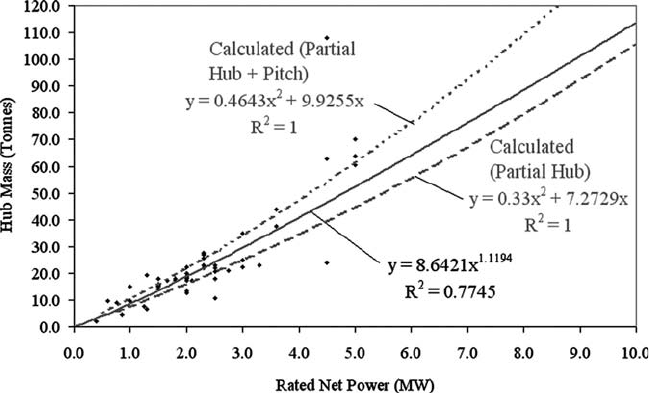
224 Wind Power Generation and Wind Turbine Design
The hydraulic design requires either electric power to be transferred across slip
rings to a hydraulic pump in the hub, which in turn supplies the individual blade
pitch cylinders, or pass hydraulic power through a rotating coupling to feed the
individual pitch cylinders. An accumulator is provided as part of the system design
to ensure that the blades can be pitched to the feathered position (under normal or
emergency stop conditions) for the case of hydraulic pressure failure.
Electrical pitch systems require electric power passed to the pitch motors
through slip rings and a backup battery system in the hub. The battery system
requires a charging system and condition monitoring with electric switchgear also
located in the hub. Batteries typically last 6 − 7 years so that at least two complete
replacements are required over the typical 20-year life of the turbine. Other design
considerations include how compact the hydraulic system may be relative to the
electrical design and the level of parasitic power requirements; i.e. does it take less
power to actuate and control a hydraulic or electrically pitched turbine.
Future large turbine pitch bearing and drive system technology may incorporate
elements of piecewise pitch angle adjustment as a function of the blade radius or
incorporate some form of effective pitch angle induced by a number of smaller
local fl ow control devices.
4.4.3 Rotor hub
The hub mass versus machine rating is presented in Fig. 22 . The industry study set
trajectory lies between the 10-turbine analysis group results for the “partial hub”
and the total hub mass that includes the pitch bearings and drive systems. A total
hub mass on the order of 110 tonnes can be expected for today’s technology
projected to the 10 MW turbine size. A reasonable stretch target for improved
Figure 22 : Hub mass − 10-turbine analysis compared to industry study set.
